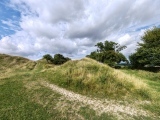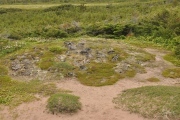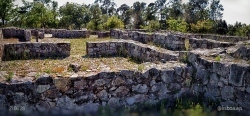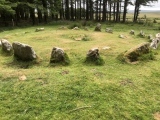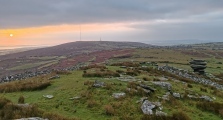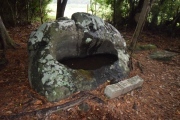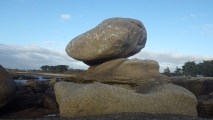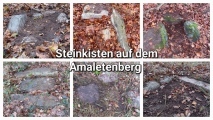Andy Burnham's Blog, page 44
December 2, 2024
Stroudhenge (Gloucestershire)
Andy B writes: Join us on BlueSky, a new social network which many stones enthusiasts and archaeologists have decamped to, having got fed up with the nonsense on Twitter (X), more details in the comments on this page. A site contribution from Simon Blackbourn via the new social network Bluesky - he writes: Despite appearances this is not thousands of years old, but a brand new stone circle, a few miles outside Stroud. We came across it while camping, after a tip-off from a taxi driver, but haven't been able to find any information about it at all. Anyone know anything about it?
Published on December 02, 2024 10:08
December 1, 2024
Hod Hill
The mighty iron-age ramparts and ditches on Hod Hill enclose an area of 22 hectares, making it the largest hillfort in Dorset. In addition to the earthwork defences, in the southeast corner there are still traces of hut circles and boundaries of the iron-age settlement. The site was captured by the Roman army in AD43, who later constructed their own fort in the north-west corner of the original hillfort.
Published on December 01, 2024 10:56
L'Anse Amour Burial Mound
L'Anse Amour, a small coastal community in Labrador, Canada, is home to one of the most significant archaeological sites in North America. This site holds a burial mound dating back approximately 7,500 years, associated with the Maritime Archaic culture. The Maritime Archaic boy, discovered in the L'Anse Amour burial mound in Labrador, Canada, with excavation completed in 1974, provides a fascinating glimpse into the lives and practices of the Maritime Archaic culture, which thrived along the Atlantic coast of North America around 7,500 to 3,000 years ago.
Published on December 01, 2024 05:22
November 28, 2024
Cividade de Bagunte
Cividade de Bagunte is a large Castro in the community of Bagunte near the town of Vila do Conde, North Portugal. This cividade has its origins in the Iron Age, around a thousand years BCE. It was then occupied by the Romans and became an important settlement up until the 4th century, with several lines of defensive walls.
Published on November 28, 2024 11:48
Soussons Common
Often referred to as a stone circle, the circle of twenty-two surviving stones are actually the kerb of a round cairn, now destroyed. In the centre lies a badly damaged burial cist.
Published on November 28, 2024 11:42
Lindisfarne Priory
The Priory holds an important collection of early carved stones. Founded in 654 AD, Holy Island is the cradle of Christianity in Britain. Site of the first Viking raid on Britain when the monastery was destroyed. Nearby Heritage Centre contains an exhibition of the Lindisfarne gospels.
Published on November 28, 2024 11:42
November 26, 2024
Stowe's Pound
Pre-Ironage and possibly Neolithic Hilltop Enclosure, Stowe’s Pound is situated on the southeast edge of Bodmin Moor. There are two enclosures, the smaller around the upper summit to the south and the larger to the north, surrounding the lower summit. The southern, upper enclosure contains an area of around 0.75ha with the flat-topped wall reaching 4.5m in height and 4m in width to the north.
Published on November 26, 2024 11:09
November 25, 2024
Ishidōnī
A drought was one of the severest disasters on the Okinawan islands, along with frequent typhoons. The Kume-jima islanders’ legend tells that during a long drought, a cow ran away into a wood then the farmer found the cow drinking the water in the hole of this stone. Following this the islanders offered prayers for rainfall here and they were rewarded.
Published on November 25, 2024 13:23
Pointe de la Jument
A large erratic stone in Finistère, called locally "Beg ar Gazeg". Could this be a human-propped stone or proto-dolmen, there are certainly many dolmens and burial chambers in the area. Presumably it would be too heavy to be moved by the waves? Thoughts anyone? [MegP Ed]
Published on November 25, 2024 09:51
November 24, 2024
Steinkisten auf dem Amaletenberg
Burial ground in Brandenburg with several stone cists on the sandy hill called Amaletenberg.
The shallow burial mounds from which the cists protruded had already been plundered when Otto von der Hagen examined this burial ground in 1905. All that was found were burnt human bones, pottery shards from urns and accompanying vessels as well as a piece of a bronze bracelet.
The shallow burial mounds from which the cists protruded had already been plundered when Otto von der Hagen examined this burial ground in 1905. All that was found were burnt human bones, pottery shards from urns and accompanying vessels as well as a piece of a bronze bracelet.
Published on November 24, 2024 09:17


